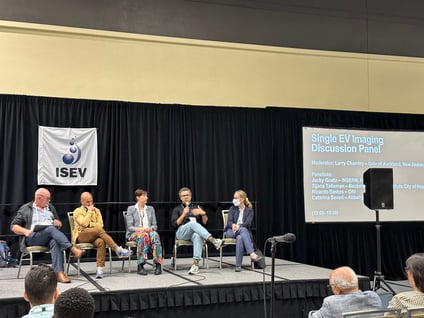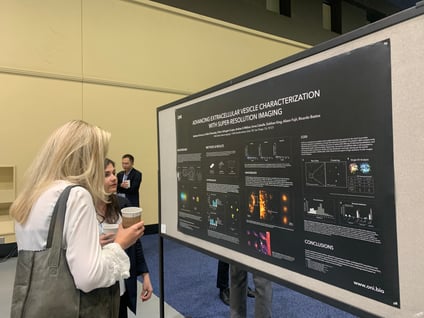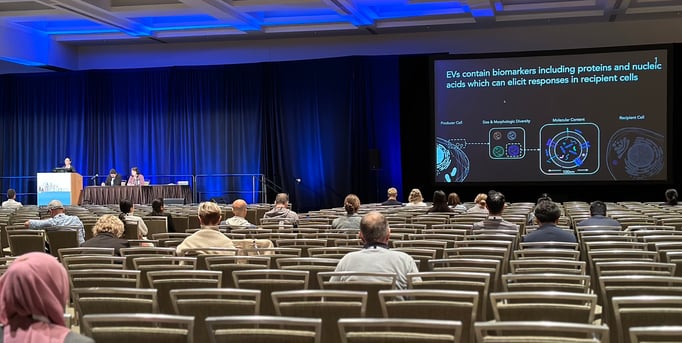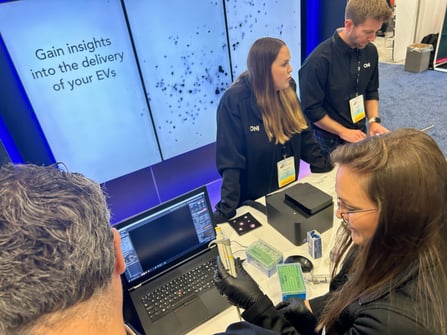The International Society of Extracellular Vesicles (ISEV) is a prominent international organization dedicated to promoting and advancing the understanding of Extracellular Vesicles (EV) biology and its potential applications in various fields, including diagnostics, therapeutics, and drug delivery. ISEV aims to foster collaboration among scientists, encourage knowledge sharing, and establish rigorous standards for EV research. By bringing together experts and enthusiasts in the field, ISEV serves as a catalyst for driving scientific breakthroughs and the translation of EV research into clinical practice.
ONI has emerged as a leading provider of cutting-edge imaging solutions tailored for the study of extracellular vesicles. With a scientific background firmly rooted in the principles of nanotechnology and advanced imaging techniques, ONI has facilitated researchers to visualize and analyze EVs at the single-particle level. By offering high-resolution, single-molecule imaging capabilities, ONI's tools empower scientists to unlock the secrets hidden within EVs, thereby accelerating discoveries in the field.
It was exhilarating to see this trend in poster presentations and talks. We saw at least ten posters and two scientific talks which featured SMLM data collected on a Nanoimager and analyzed in CODI. These included studies examining the internal and external biomarkers of EVs from chronically infected T-cell lines, characterization from EVs from colorectal cancer patients, urine derived EVs for renal injury and premature aging, and exosomes mediating delivery of Cas9 ribonucleoprotein complexes for gene editing in skeletal muscle. Additionally, several studies utilized the EV Profiler kit, the Nanoimager, and CODI analysis to optimize EV generation, isolation, and characterization from various cell culture modalities.
In the scientific sessions, SMLM was highlighted for single EV analysis. Several talks also focused on various developing methodologies for label-free detection of EVs both isolated and within tissues. A major focus for the future in the field seems to be understanding the mechanisms of EV signaling including biogenesis and uptake. To this end, Ricardo Bastos, Director of Business Development from ONI, joined Jacky Goetz from Université de Strasbourg, France, Tijana Talisman from City of Hope, USA, and Caterina Severi from Abbelight in a single EV imaging panel moderated by Larry Chamley from University of Auckland, New Zealand. Current limitations and advancements in single EV imaging and discussions regarding the collaboration between academics and industry were the highlight of the hour.


I was fortunate to present a scientific talk on the last day of the meeting sharing ongoing projects within our R&D team, where we can assess EV cargo (in particular RNA binding protein, Ago2) using advancements to our EV Profiler kit and CODI analysis in EVs affinity isolated from human milk, plasma, and urine. We were so excited to show some of the ongoing interests and investments we are working on to make single EV imaging more robust and to aid in tackling the most pressing ongoing questions in the field.

ISEV has been instrumental in defining EV analysis parameters and multimodal characterization. Researchers and commercial exhibitors have a collaborative spirit to support each other in advancing this mission. Over the last year, there have been advances in the production, isolation, and characterization of field-wide EV standards which has facilitated novel and validated discoveries. At ONI, our mission to democratize super resolution imaging and analysis intimately aligns with this communal mission. We were so excited to see researchers using our EV Profiler kit, Nanoimager, and CODI analysis software to collect and share data amongst groups and to validate this technology with other, independent analysis. We are proud that researchers are trusting us with their single EV analysis and were ecstatic to hear several researchers verbalizing the characterization of EVs with an EV Profiler kit and Nanoimager, saying “Have you ONIed your sample?” Overall, we are grateful to be trusted with this EV analysis and are excited to see all of the advancements and discoveries that the coming year brings.
EV customers are starting to ask "Have you ONIed your sample?”, referring to using ONI's EV Profiler Kit for sample preparation, the Nanoimager microscope for imaging and CODI software for data analysis.


During the meeting, ONI also announced the launch of its annual EV competition! The competition gives the best EV-focused entries the chance to win a FREE 3-month subscription for the Nanoimager.
Submit your entry here by August 9th: https://pages.oni.bio/ev-competition-2023
The ISEV Annual Meeting 2023 was an exciting gathering that brought together the brightest minds in the field of extracellular vesicle research. With each new discovery and collaboration, the boundaries of knowledge in EV biology are being pushed further, opening up possibilities for diagnostics, therapeutics, and beyond. ONI is grateful to our customers who highlighted the many uses of our EV Profiler kit, Nanoimager, and CODI software. We remain committed to providing scientists with the most advanced imaging solutions and look forward to seeing continued advancements and discoveries in the field next year at ISEV 2024 in Melbourne, Australia. We hope to see you there!
If you would like to learn more about our complete solution for super-resolution imaging and EV characterization, visit our website and dedicated EV Hub section. You can also reach out to the team at hi@oni.team.
Share this article: